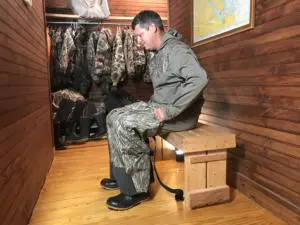Menu

Normally you don’t buy shoes, pants and a vest at the same time, but when you buy a chest wader, you are doing exactly that. There is not an industry standard to sizing, which can make it that much more difficult. While we are not all created the same, there are some good guidelines follow when buying a chest wader whether neoprene or breathable.
Start with your shoe size. A chest wader is essentially a boot that continues up the body, so it’s important to start with the core of the product. If your boot is too tight, you will be uncomfortable for multiple reasons. It might pinch your foot causing unneeded discomfort; it will compact your socks and that all-essential barrier of air that acts as an insulator, in turn causing your feet to get cold faster. If the boot is too big, walking can be difficult to impossible as mud comes up over and above the ankles. Find a boot that fits and is not overly bulky. Also watch out for “moon boots” that are made up of just a thin layer of rubber and a lot of Thinsulate. The 1600g of Thinsulate might sound tempting, but it can be a hindrance in a cheap bulky boot that is hard to walk in, and its only selling point is a lot of insulation. Think about a boot with a dual layer system of Neoprene and Thinsulate partnered with a top-quality merino wool sock as a complete system to keep your feet warm and you mobile.
Moving on up. Regarding the upper part of the wader, the most important things to consider are inseam (heel to crotch), outseam (heel to underarm), chest and waist. Certain brands will only offer a standard size. This might work great if you fit the mold of “average” shape and build, but they often make them a little larger than necessary to be more of a one size fits all. There are a lot of folks out there that don’t fit this mold and will need to look further at tall and stout sizes. A tall will typically offer a larger inseam and outseam, while a stout will offer a larger chest, waist and hip measurement, sometimes with a shorter inseam and outseam. It really differs by brand.
Neoprene waders vs breathable waders regarding material and fit. Neoprene and breathable fabrics have very different physical characteristics. Neoprene has some stretch, but is bulky; any excess material can easily cause discomfort. Too much inseam will push up into the crotch, too much outseam and the material will push into your armpits, too much material in the chest will just get in the way of your movement. Not enough and you won’t be able to layer up underneath. As a result, neoprene waders are cut much more trim vs their breathable counterparts. Breathable fabric does not stretch, but is much more lightweight and extra material typically can fold up inconsequentially. Lacking insulation, breathable waders will also need the extra material to accommodate extra layers underneath. (Yes, some waders do come with built in insulation which we do not recommend for multiple reasons.)
The size chart on a wader may not look the same or even close to the size chart of your dress shirt or jeans. The inseam will be longer because the boot is attached to your pant. We also need some extra room inside of our wader for one to three layers you may want to wear underneath.
The key takeaway is to start with your shoe size. Check with the manufacturer tosee if the boot fit is “True to size” or otherwise. Brands that only offer a standard size upper often try to be a one size fits all, a brand that offers tall and stout sizes beyond the regular size most likely will have a better fit for your body type. You probably know if you are a regular, tall or stout by the clothes that you normally wear. Luckily, we aren’t walking down the runway in our waders (or maybe you are, should you have bought a certain pair of thousand dollar waders, you have certainly paid designer prices…) and there is a decent amount of wiggle room if there is a little bit of extra fabric. First look at the size chart of the wader and don’t hesitate to inquire before you buy. If you have any questions ask a qualified salesperson or manufacturer what they would recommend depending on your measurements and body type.
In our outdoor pursuits we spend a lot of time and money to do the things that we need, and/or love to do. Do your due diligence and get a good fit to ensure that you are warm, dry and comfortable in your waders so that you can focus on what is most important when the time comes.